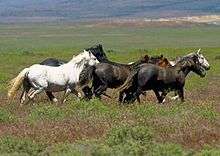Flaxen gene

The flaxen gene is a genetic mechanism that causes the mane and tail of chestnut-colored horses to be noticeably lighter than the body coat color, often a golden blonde shade. Certain horse breeds such as the Haflinger carry flaxen chestnut coloration as a breed trait. It is common in chestnut-colored animals of other horse breeds that may not be exclusively chestnut.
Studies on Morgan horses have indicated that the flaxen trait is inherited, but the genetic mechanism that produces the trait is not yet mapped.[1] The trait may be produced by a homozygous recessive allele.[2] Evidence of a recessive mode of Mendelian inheritance exists in preliminary studies showing that flaxen chestnut horses mated with other flaxen chestnut horses consistently produce only flaxen chestnuts. The degree of expression of the trait is highly variable, however: some chestnut horses that do not exhibit much flaxen may nonetheless produce strongly flaxen offspring. Thus, some researchers hypothesize that there is more than one gene involved.[1] The flaxen gene does not affect black or bay horses, only chestnuts. However, as there are examples of flaxen chestnuts born to parents that are black or bay, it is hypothesized that it can be masked in darker-colored horses but still passed on to their offspring.[2]
-
.jpg)
A chestnut horse with a slightly lighter mane and tail, minimally expressed flaxen
-

This pony is described as a dark liver chestnut with flaxen, but could also be a horse with the silver dapple gene
-
Detail of a flaxen tail, note darker chestnut hairs at dock
-

Many chestnut horses do not carry flaxen and their manes and tails are a similar shade to their body color
Flaxen mimics


Coloration of a light mane and tail with darker body color may be created by other genetic mechanisms known as dilution genes, most of which can be detected by DNA testing. The most common is palomino, created by one copy of the cream gene acting on a chestnut coat, resulting in a gold-colored coat with a white or cream colored mane and tail. Deep gold palominos may be hard to distinguish from light chestnuts with significant expression of flaxen, but genetic tests can aid determination of color. The Champagne gene acting on a chestnut coat may also produce a horse with a gold coat and ivory mane and tail, distinguishable from palomino by freckled skin and light-colored eyes.[3] In most cases, a chestnut with flaxen can be distinguished from other colors by the presence of some reddish, chestnut hairs in the mane or tail.
The silver or silver dapple gene acts only on black hair. On a black base coat, it lightens the body to a brown color and the mane/tail to a cream or silver shade; on a bay base coat, it lightens the mane and tail to cream or silver. It does not affect chestnut (red) coloring. A genetic test exists for the silver gene.[3]
References
- 1 2 Authors, Multiple (2009-10-02). "Flaxen Color Genetic Research in Progress". TheHorse.com. Retrieved 2014-07-14.
- 1 2 Authors, Multiple (2010-02-08). "Flaxen Chestnut Color Inheritance Studied". TheHorse.com. Retrieved 2014-07-14.
- 1 2 "Equine Coat Color Genetics 101". TheHorse.com. 2013-04-05. Retrieved 2014-07-14.
